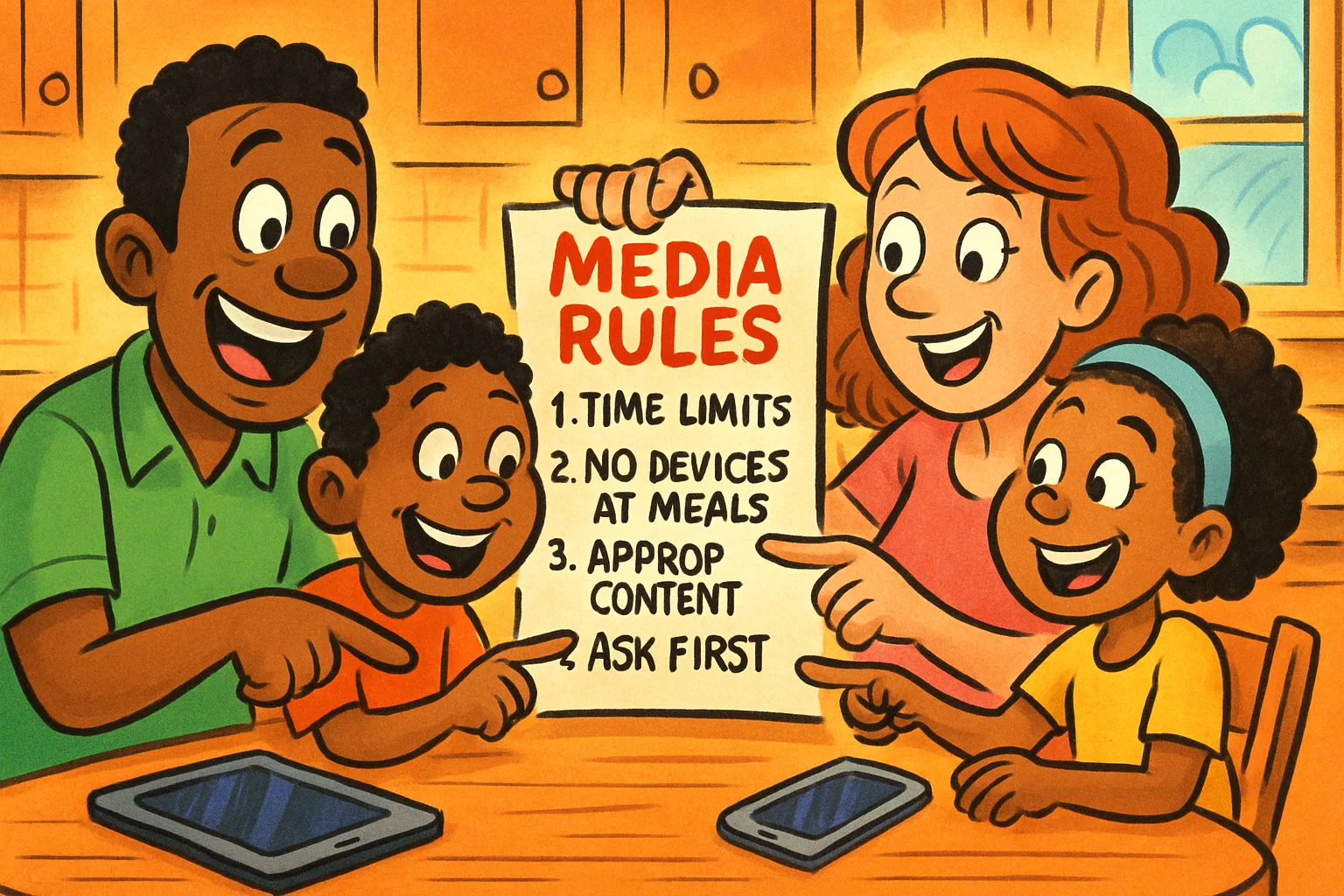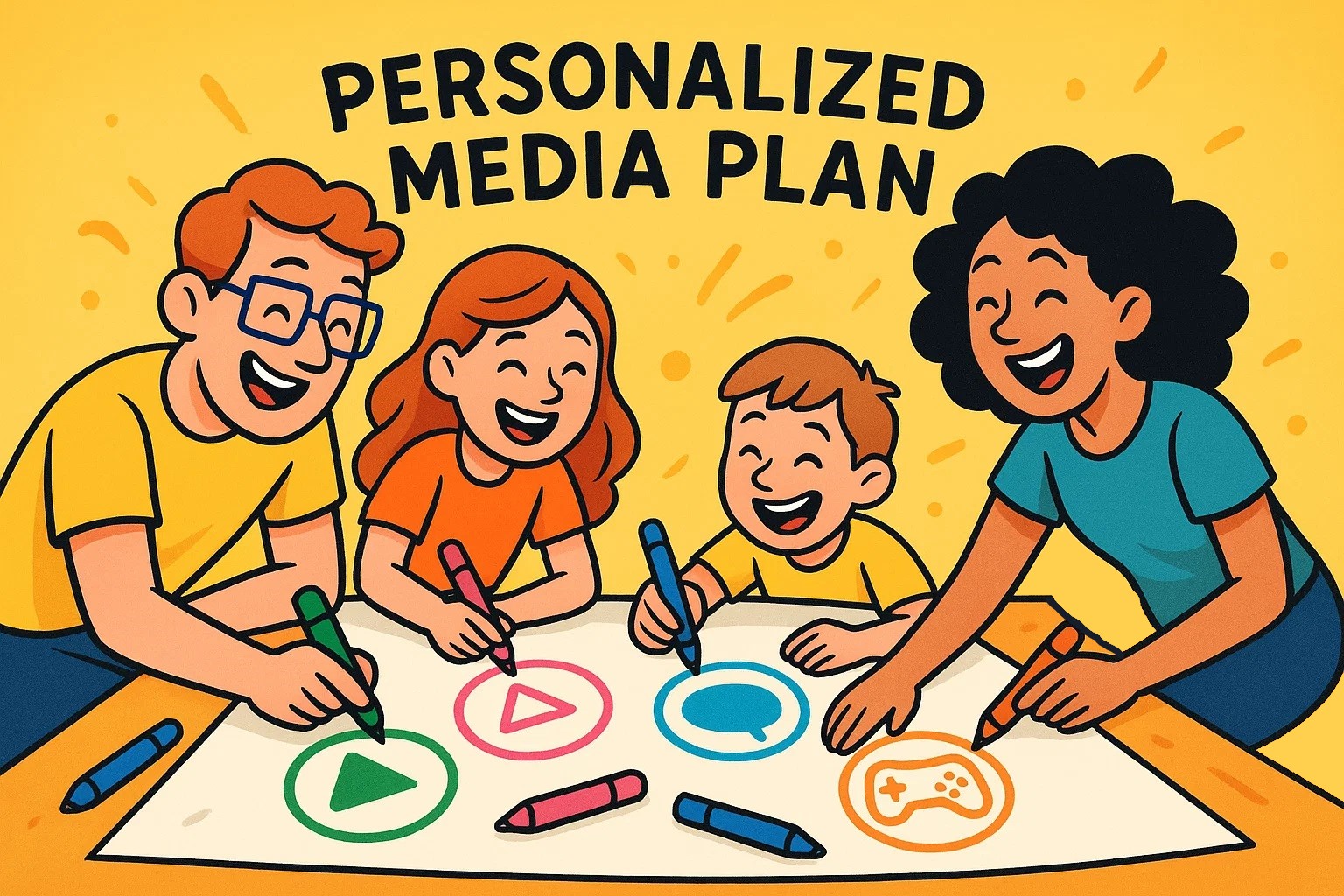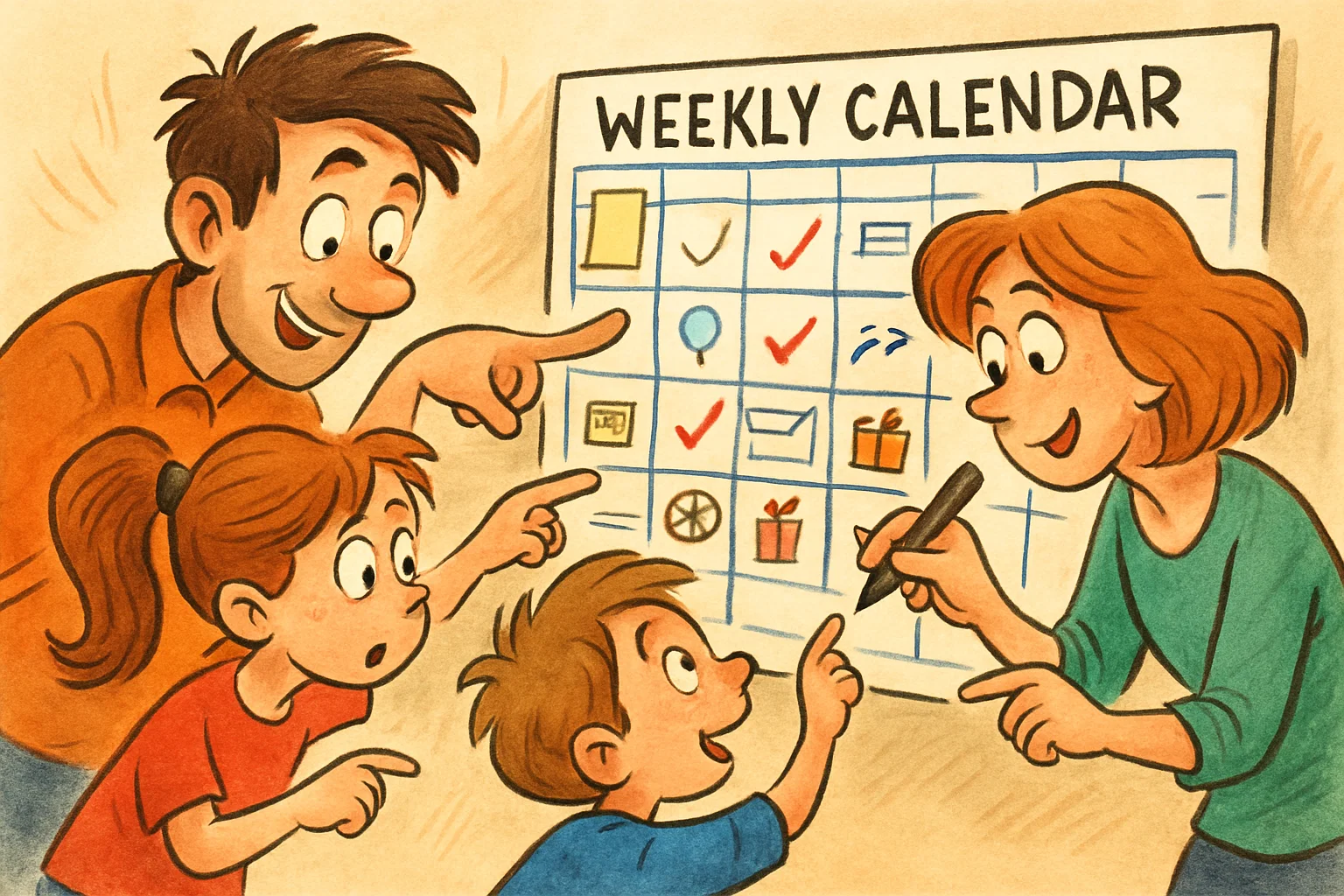Family Media Plan: Healthier Digital Habits for the Whole Family

In today’s digital world, screens are everywhere—from smartphones and tablets to gaming devices and smart TVs. While technology offers incredible opportunities for learning, creativity, and connection, it can also interfere with family time, sleep, and face-to-face interaction. A well-crafted family media plan serves as your roadmap to developing healthy digital habits that work for everyone in your household.
Research from Rachel Barr suggests that children who grow up with clear, consistent media guidelines tend to develop better self-regulation skills and maintain healthier relationships with technology throughout their lives. By establishing a family media plan, you’re not just setting screen time limits—you’re teaching your children how to use technology intentionally and responsibly.
Why a Family Media Plan Promotes Healthier Habits

A family media plan helps set clear rules and boundaries, turning screen time into a thoughtful, intentional activity that supports family values and strengthens relationships.
Establish Rules for Media Use 📱
Creating structured rules for media use helps transform chaotic screen time into purposeful digital engagement. When families operate without clear boundaries, technology use often becomes reactive rather than intentional. Children may grab devices during homework time, at the dinner table, or right before bed—habits that can interfere with learning, family connection, and sleep quality.
A comprehensive family media plan addresses several key areas:
- Time-based boundaries: Specific hours when devices are allowed or prohibited
- Location restrictions: Screen-free zones like bedrooms and dining areas
- Content guidelines: Age-appropriate material and platform restrictions
- Usage priorities: Homework and responsibilities before entertainment media
The beauty of establishing these rules collectively is that they become family agreements rather than arbitrary restrictions imposed by parents. This collaborative approach tends to result in better compliance and fewer conflicts about technology use.
The Benefits of a Family Media Plan
A 2023 study from Emory University Hospital Midtown, Atlanta found that children in families with clear digital boundaries showed improved attention spans, better sleep patterns, and stronger family relationships compared to those without such guidelines.
Key benefits include:
| Benefit Area | Specific Improvements |
| Family Relationships | More face-to-face conversation, shared activities, reduced conflicts over devices |
| Academic Performance | Better focus during homework, improved time management skills |
| Physical Health | Increased physical activity, better posture, reduced eye strain |
| Mental Wellbeing | Lower anxiety levels, improved self-regulation, better emotional awareness |
| Sleep Quality | Earlier bedtimes, more restful sleep, better morning routines |
These improvements don’t happen overnight, but families typically notice positive changes within 2-4 weeks of implementing a consistent plan. The key lies in making the plan realistic and sustainable for your family’s unique circumstances.
Creating a Plan Together 🤝
The most effective family media plans emerge through collaborative discussion rather than top-down rule-making. When you involve every family member in the planning process, you tap into their insights about what works and what doesn’t in your daily routines.
Start by gathering everyone for a family meeting focused on your relationship with technology. Ask open-ended questions like: “When do our devices help us, and when do they get in the way?” or “What are our family’s most important values, and how can our technology use support those values?”
This collaborative approach serves multiple purposes. Children feel heard and respected when their opinions matter in family decisions. They’re also more likely to follow guidelines they helped create. Additionally, this process opens ongoing communication channels about technology use, making it easier to address challenges as they arise.
Consider appointing different family members to research specific aspects of your plan. One child might investigate parental control options, while another explores screen-free activity ideas. This distributed responsibility creates buy-in and helps everyone understand the reasoning behind your family’s choices.
How to Create a Customized Family Media Plan

Learn how to build a plan that fits your family’s unique needs. You’ll create personalized rules and guidelines that work for everyone, from the youngest child to the adults.
Aligning Digital Rules with Family Values
Your family media plan should reflect your unique priorities and circumstances rather than following a one-size-fits-all template. Begin by identifying your family’s core values—perhaps creativity, learning, physical activity, or strong relationships—and consider how your technology use can support rather than undermine these priorities.
For families who value creativity, your plan might encourage using devices for artistic projects, music creation, or storytelling while limiting passive consumption. Families prioritizing physical activity might establish that outdoor play or exercise must happen before any recreational screen time begins.
Questions to guide your value-based planning:
- What activities bring our family the most joy and connection?
- When does technology enhance our lives versus distract from what matters?
- How can we use digital tools to support learning and growth?
- What boundaries will help us prioritize face-to-face relationships?
Remember that your values may evolve over time, and your media plan should adapt accordingly. Regular family check-ins can help ensure your digital habits continue supporting what matters most to your household.
Creating a Plan for Every Member
Effective family media plans recognize that different family members have different needs, responsibilities, and relationships with technology. While consistency is important, rigid uniformity often leads to frustration and rebellion.
Parents might need devices for work-related tasks that wouldn’t be appropriate for children. Teenagers developing independence may benefit from slightly more flexibility than younger siblings. The goal is creating a framework that’s fair and logical while accommodating these natural differences.
Consider these factors for each family member:
- Age and developmental stage: Younger children typically need more structure and shorter time limits
- Responsibilities: School demands, work requirements, and family obligations
- Individual challenges: Some children struggle more with self-regulation than others
- Special interests: A child passionate about coding might have different needs than one focused on sports
Document each person’s guidelines clearly, but avoid making the plan so complex that it becomes difficult to follow. Simple, memorable rules work better than elaborate systems requiring constant monitoring.
Customizing for Different Age Groups 👶🧒👦👧
Age-appropriate media planning recognizes that children’s cognitive and emotional development affects how they interact with technology. What works for a preschooler won’t necessarily suit a teenager, and trying to apply identical rules across age groups often creates unnecessary conflict.
Preschoolers (Ages 2-5):
- Focus on high-quality, educational content watched together with adults
- Limit total screen time to 1 hour per weekday, with flexibility on weekends
- Emphasize interactive content that promotes learning and creativity
- Avoid screens during meals and within 1 hour of bedtime
- Use parental controls to prevent access to inappropriate content
School-Age Children (Ages 6-12):
- Expand content options while maintaining clear boundaries
- Introduce homework completion as a prerequisite for entertainment media
- Begin teaching basic digital citizenship concepts
- Allow some independence while maintaining oversight of online activities
- Establish screen-free times during family meals and outings
Teenagers (Ages 13-18):
- Shift toward collaborative boundary-setting rather than imposed restrictions
- Focus on time management and self-regulation skills
- Address privacy, online relationships, and digital reputation
- Discuss cyberbullying prevention and response strategies
- Encourage critical thinking about social media and online content
These age-based guidelines provide a starting framework, but individual children may need modifications based on their maturity, self-control, and specific circumstances.
Tips for Maintaining and Revisiting Your Plan

A media plan is a living document. Discover simple strategies for keeping your rules relevant and effective as your family grows and technology changes.
Keeping a Family Media Plan Effective 🔄
Creating a family media plan is just the beginning—maintaining its effectiveness requires ongoing attention and adjustment. Many families start strong but gradually drift back into old habits without regular reinforcement and evaluation.
Strategies for sustained success:
Weekly Check-Ins: Schedule brief family meetings to discuss how the plan is working. What’s going well? What challenges are emerging? These conversations help identify problems before they become major conflicts.
Consistent Enforcement: Everyone in the family, including parents, should follow the agreed-upon guidelines. Children quickly notice when adults don’t model the behaviors they’re asking for, which undermines the plan’s credibility.
Positive Reinforcement: Acknowledge when family members successfully follow the plan rather than only addressing violations. This might involve praising a child who completes homework before using devices or thanking a teen for putting their phone away during dinner.
Flexibility When Needed: Life circumstances change, and your media plan should adapt accordingly. A sick day, special family event, or unusual work deadline might require temporary modifications to your normal routine.
Use Parental Control Tools Wisely: Technology can help enforce your family’s agreements, but it shouldn’t replace communication and trust-building. Use apps and settings as backup support rather than primary enforcement mechanisms.
Revisiting and Adjusting the Plan
Family media plans aren’t permanent documents—they’re living agreements that should evolve as your family grows and changes. Plan to formally review and update your guidelines every 3-6 months, or whenever significant changes occur in your household.
Triggers for plan revision:
- Children advancing to new developmental stages
- Changes in school schedules or extracurricular activities
- Introduction of new devices or platforms
- Emerging challenges with current guidelines
- Shifts in family priorities or circumstances
During revision sessions, celebrate successes before addressing problems. What aspects of your plan have worked well? How has your family’s relationship with technology improved? This positive foundation makes it easier to tackle areas needing adjustment.
Ask each family member to suggest one change they’d like to see in the updated plan. These suggestions might reveal insights you hadn’t considered and help maintain everyone’s investment in the process.
Promoting Long-Term Healthier Habits 🌱
The ultimate goal of a family media plan extends beyond managing screen time—you’re helping your children develop internal regulation skills that will serve them throughout their lives. This long-term perspective influences how you approach both successes and setbacks.
Building internal motivation:
Rather than relying solely on external controls, gradually help children understand why certain boundaries exist. Explain how excessive screen time affects sleep, how certain content influences mood, or how face-to-face interaction builds stronger relationships.
Teaching self-monitoring:
Encourage family members to notice their own responses to different types of media use. How do they feel after spending time on social media versus creating something digitally? What happens to their energy levels during extended gaming sessions?
Modeling healthy habits:
Children learn more from observing adult behavior than from listening to rules. When parents demonstrate intentional technology use—putting devices away during conversations, choosing quality content, taking regular digital breaks—children naturally absorb these patterns.
Connecting digital and offline experiences:
Help children see technology as one tool among many rather than a separate world. Encourage them to share interesting online discoveries with family members, use digital tools to plan offline activities, or create content that reflects their real-world interests and experiences.
Digital Citizenship and Online Safety

Go beyond screen limits by teaching children the skills they need to be responsible and safe online. This section covers everything from online etiquette to protecting personal information.
Teaching Digital Responsibility 🛡️
Digital citizenship encompasses the skills, attitudes, and behaviors needed to be a responsible, ethical participant in online communities. Just as you teach children to treat others respectfully in face-to-face interactions, you must help them develop similar competencies in digital spaces.
Core digital citizenship concepts:
Respect and Empathy: Help children understand that real people exist behind usernames and profiles. Encourage them to consider how their online words and actions affect others, just as they would in person.
Privacy Awareness: Teach children to think carefully before sharing personal information online. This includes photos, location data, school information, and family details that could be misused by inappropriate individuals.
Critical Thinking: Young people need skills to evaluate online information critically. With the rise of AI-generated content and sophisticated misinformation, children must learn to question sources and verify claims.
Appropriate Communication: Online communication lacks many social cues present in face-to-face interaction. Help children understand how tone can be misinterpreted in text and teach them to communicate clearly and respectfully.
Digital Footprints: Everything shared online potentially becomes part of a permanent record. Help children understand that future opportunities—college admissions, jobs, relationships—may be influenced by their digital history.
These concepts require ongoing reinforcement rather than one-time lessons. Look for natural opportunities to discuss digital citizenship as situations arise in your child’s online experiences.
Setting Rules for Online Safety
Online safety rules should be specific, understandable, and regularly updated as children gain access to new platforms and technologies. Vague guidelines like “be safe online” provide insufficient guidance for young people navigating complex digital environments.
Essential safety rules to establish:
| Safety Area | Specific Guidelines |
| Personal Information | Never share full name, address, school, phone number, or family details with unknown individuals |
| Meeting Online Friends | Online relationships should remain online; never meet strangers without parental involvement |
| Inappropriate Content | Report disturbing images, messages, or requests to trusted adults immediately |
| Cyberbullying Response | Don’t engage with bullies; document evidence; seek adult support promptly |
| Password Security | Use strong, unique passwords; never share login credentials with peers |
| Platform Age Requirements | Respect minimum age requirements for social media and gaming platforms |
Creating reporting procedures:
Children need clear, non-punitive ways to report concerning online experiences. Establish that they won’t lose device privileges for encountering problems they didn’t seek out or for making honest mistakes. This approach encourages open communication when issues arise.
Practice these reporting procedures during calm moments so children know what to do during stressful situations. Role-play scenarios like receiving inappropriate messages or witnessing cyberbullying to build confidence and competence.
Promoting Positive Online Experiences
While much discussion of children’s internet use focuses on risks and restrictions, it’s equally important to actively cultivate positive digital experiences. When children find meaningful, engaging ways to use technology, they’re naturally less drawn to problematic content or behaviors.
Ways to encourage positive online engagement:
Creative Expression: Support children in using digital tools for art, music, writing, video creation, or other creative pursuits that reflect their interests and talents.
Learning Opportunities: Help children discover educational content that deepens their understanding of subjects they’re passionate about, from science experiments to historical documentaries to language learning apps.
Positive Communities: Guide children toward age-appropriate online communities centered around their interests—whether robotics clubs, book discussion groups, or sports teams—where they can connect with like-minded peers.
Digital Volunteering: Older children and teens might contribute to positive causes through online volunteering, such as tutoring younger students, participating in citizen science projects, or supporting charitable organizations.
Family Connection: Use technology to strengthen family relationships through shared gaming, collaborative creative projects, or staying connected with distant relatives.
Remember that positive online experiences don’t happen automatically—they require the same intentional cultivation as positive offline experiences. Regular conversations about what children are discovering and enjoying online help you guide them toward enriching digital activities.
Frequently Asked Questions
How much screen time is appropriate for different age groups?
The American Academy of Pediatrics suggests avoiding screens for children under 18 months (except video chatting), limiting 18-24 month olds to high-quality programming watched with parents, and allowing 2-5 year olds up to one hour of high-quality content daily. For school-age children and teens, focus on ensuring screen time doesn’t interfere with sleep, physical activity, homework, and face-to-face social interaction rather than adhering to strict time limits.
What should I do if my child repeatedly violates our family media plan?
First, examine whether the rules are realistic and age-appropriate. Frequent violations may indicate that expectations need adjustment. If the guidelines are reasonable, implement natural consequences consistently—such as temporary loss of device privileges—while discussing why the boundaries exist. Most importantly, look for underlying issues like boredom, social problems, or difficulty with self-regulation that might be driving the behavior.
How can I monitor my child's online activity without invading their privacy?
Balance supervision with privacy by using age-appropriate monitoring strategies. For younger children, active co-viewing and open device use in common areas provide natural oversight. As children mature, shift toward periodic check-ins, parental control software that blocks inappropriate content rather than tracking every activity, and ongoing conversations about online experiences. Transparency about monitoring helps maintain trust.
What's the best way to handle disagreements about screen time rules?
Address disagreements through family meetings where everyone can express their perspectives respectfully. Ask children to explain their reasoning and share your concerns clearly. Look for compromise solutions that honor both your parental responsibility and their developing independence. Sometimes temporary trial periods for modified rules can help determine what works best for your family.
How do I create consequences that actually motivate my child to follow our digital agreements?
Effective consequences are natural, immediate, and proportional to the violation. Rather than lengthy device bans that may be difficult to enforce, try shorter but consistent consequences paired with opportunities to earn back privileges through positive behavior. Focus on helping children understand the connection between their choices and outcomes while maintaining a supportive relationship throughout the process.
